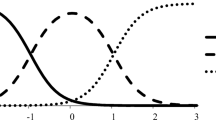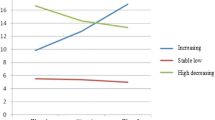Abstract
The Strengths and Difficulties Questionnaire (SDQ) is the most widely used mental health screening instrument for children and adolescents. It is a short questionnaire including 25 items that can be answered by parents, teachers or children. There are two studies which report norms for the German SDQ parent version. They do not include children younger than 6 years. Moreover, whether the German SDQ parent version is measurement invariant across age has not yet been investigated. The absence of measurement invariance across age would support the use of age-specific norms that are not yet available for the German SDQ parent version. We used data of the German Health Interview and Examination Survey for Children and Adolescents (KiGGS), a nationally representative survey including 14,835 children aged 3–17 years, to assess measurement invariance of the German SDQ parent version across the full age range. Multi-group confirmatory factor analysis revealed that the hyperactivity and emotional symptoms subscales are not comparable between children of different ages. This supports the use of age-specific norms for these two subscales and for the total SDQ. We used methods of centile estimation to smoothly model the centiles of the SDQ total score and the subscale scores in dependence on age. These age-specific centiles reflect the developmental course of SDQ problems in children (including preschoolers) and adolescents living in Germany. They can be used to identify children and adolescents with abnormal behaviour, while accounting for the developmental course of emotional and behaviour problems.


Similar content being viewed by others
Notes
The original SDQ differs from this early-year version in the wording of three items (two items of the behaviour problem subscale and one item of the hyperactivity subscale; see http://www.sdqinfo.org).
Kline [26], for example, suggests a minimum of 100 subjects per group.
References
Cicchetti D (2006) Development and psychopathology. In: Cicchetti D, Cohen DJ (eds) Developmental psychopathology, Vol 1: theory and method, 2nd edn. Wiley, Hoboken
Hudziak JJ et al (2007) A dimensional approach to developmental psychopathology. Int J Methods Psychiatr Res 16(Suppl 1):S16–S23
Goodman R (1997) The Strengths and Difficulties Questionnaire: a research note. J Child Psychol Psychiatry 38(5):581–586
Goodman R et al (2000) Using the Strengths and Difficulties Questionnaire (SDQ) to screen for child psychiatric disorders in a community sample. Br J Psychiatry 177:534–539
Stone LL et al (2010) Psychometric properties of the parent and teacher versions of the Strengths and Difficulties Questionnaire for 4- to 12-year-olds: a review. Clin Child Fam Psychol Rev 13(3):254–274
Barkmann C, Schulte-Markwort M (2004) Prävalenz psychischer Auffälligkeit bei Kindern und Jugendlichen in Deutschland - ein systematischer Literaturüberblick. Psychiatr Prax 31(6):278–287
Goodman A, Lamping DL, Ploubidis GB (2010) When to use broader internalising and externalising subscales instead of the hypothesised five subscales on the Strengths and Difficulties Questionnaire (SDQ): data from British parents, teachers and children. J Abnorm Child Psychol 38(8):1179–1191
Becker A et al (2006) Psychopathological screening of children with ADHD: Strengths and Difficulties Questionnaire in a pan-European study. Eur Child Adolesc Psychiatry 15(Suppl 1):56–62
Becker A et al (2004) Validation of the parent and teacher SDQ in a clinical sample. Eur Child Adolesc Psychiatry 13(Suppl 2):11–16
Klein AM et al (2013) Psychometric properties of the parent-rated SDQ in preschoolers. Eur J Psychol Assess 29(2):96–104
Rothenberger A et al (2008) Psychometric properties of the parent strengths and difficulties questionnaire in the general population of German children and adolescents: results of the BELLA study. Eur Child Adolesc Psychiatry 17(Suppl 1):99–105
Woerner W et al (2002) Normierung und Evaluation der deutschen Elternversion des Strengths and Difficulties Questionnaire (SDQ): Ergebnisse einer repräsentativen Felderhebung. Zeitschrift fur Kinder- und Jugendpsychiatrie und Psychotherapie 30(2):105–112
Woerner W, Becker A, Rothenberger A (2004) Normative data and scale properties of the German parent SDQ. Eur Child Adolesc Psychiatry 13(Suppl 2):3–10
Stone LL et al (2010) Psychometric properties of the parent and teacher versions of the Strengths and Difficulties Questionnaire for 4- to 12-year-olds: a review. Clin Child Fam Psychol Rev 13(3):254–274
Goodman A, Goodman R (2011) Population mean scores predict child mental disorder rates: validating SDQ prevalence estimators in Britain. J Child Psychol Psychiatry 52(1):100–108
Hölling H et al (2007) Behavioral problems in children and adolescents. First results of the German Health Interview and Examination Survey for Children and Adolescents (KiGGS) [Verhaltensauffälligkeiten bei Kindern und Jugendlichen. Erste Ergebnisse aus dem Kinder- und Jugendgesundheitssurvey (KiGGS)]. Bundesgesundheitsblatt 50(5–6):784–793
Kurth BM (2007) The German Health Interview and Examination Survey for Children and Adolescents (KiGGS): an overview of its planning, implementation and results taking into account aspects of quality management. Bundesgesundheitsblatt 50(5–6):533–546
Rothenberger A et al (2008) Psychometric properties of the parent Strengths and Difficulties Questionnaire in the general population of German children and adolescents: results of the BELLA study. Eur Child Adolesc Psychiatry 17(Suppl 1):99–105
Hölling H et al (2012) Die KiGGS-Studie. Bundesweit repräsentative Längs- und Querschnittstudie zur Gesundheit von Kindern und Jugendlichen im Rahmen des Gesundheitsmonitorings am Robert Koch-Institut. Bundesgesundheitsblatt 55(6):836–842
Kamtsiuris P, Lange M, Rosario AS (2007) Der Kinder-und Jugendgesundheitssurvey (KiGGS): Stichprobendesign, Response und Nonresponse-Analyse. Bundesgesundheitsblatt 50(5):547–556
Kurth B-M et al (2008) The challenge of comprehensively mapping children’s health in a nation-wide health survey: design of the German KiGGS-Study. BMC Public Health 8:196
Muthén B (1984) A general structural equation model with dichotomous, ordered categorical, and continuous latent variable indicators. Psychometrika 49(1):115–132
Schermelleh-Engel K, Moosbrugger H, Müller H (2003) Evaluating the fit of structural equation models: tests of significance and descriptive goodness-of-fit measures. Methods Psychol Res Online 8(2):23–74
Bentler PM (1990) Comparative fit indexes in structural models. Psychol Bull 107(2):238–246
Schreiber JB et al (2006) Reporting structural equation modeling and confirmatory factor analysis results: a review. J Educ Res 99(6):323–338
Kline T (2005) Psychological testing: a practical approach to design and evaluation. Sage Publications, Inc, Thousand Oaks, CA
Muthén L, Muthén B (1998–2010) Mplus user’s guide, 6th edn. Muthén & Muthén, Los Angeles
Bowen N, Masa R (2015) Conducting measurement invariance tests with ordinal data: a guide for social work researchers. J Soc Soc Work Res 6(2):229–249
Chen FF (2007) Sensitivity of goodness of fit indexes to lack of measurement invariance. Struct Equ Model 14(3):464–504
Cheung GW, Rensvold RB (2002) Evaluating goodness-of-fit indexes for testing measurement invariance. Struct Equ Model 9(2):233–255
Meade AW, Johnson EC, Braddy PW (2008) Power and sensitivity of alternative fit indices in tests of measurement invariance. J Appl Psychol 93(3):568–592
Rigby RA, Stasinopoulos DM (2004) Smooth centile curves for skew and kurtotic data modelled using the Box–Cox power exponential distribution. Stat Med 23(19):3053–3076
Buuren SV, Fredriks M (2001) Worm plot: a simple diagnostic device for modelling growth reference curves. Stat Med 20(8):1259–1277
Royston P, Wright E (2000) Goodness-of-fit statistics for age-specific reference intervals. Stat Med 19(21):2943–2962
Rosseel Y (2012) lavaan: an R package for structural equation modeling. J Stat Softw 48(2):1–36
Stasinopoulos DM, Rigby RA (2007) Generalized additive models for location scale and shape (GAMLSS) in R. J Stat Softw 23(7):1–46
Acknowledgements
The authors thank Angelika Schaffrath Rosario for helpful comments on centile curves and Carol Wallis for language corrections.
Funding
Funding was provided by Bundesministerium für Gesundheit.
Author information
Authors and Affiliations
Corresponding author
Ethics declarations
Conflict of interest
The authors declare that they have no conflict of interest.
Electronic supplementary material
Below is the link to the electronic supplementary material.
787_2019_1337_MOESM1_ESM.pdf
Supplementary material 1 (PDF 313 kb) Online Resource 1 Results of confirmatory factor analysis showing the SDQ five-factor model based on the total study population as well as stratified by sex
787_2019_1337_MOESM2_ESM.pdf
Supplementary material 2 (PDF 759 kb) Online Resource 2 Results of multi-group confirmatory factor analysis showing unstandardized and standardized factor loadings and thresholds for each age-group of the partial strong invariance model (for boys and girls)
787_2019_1337_MOESM3_ESM.pdf
Supplementary material 3 (PDF 173 kb) Online Resource 3 Norm values for the five SDQ-P subscales (non age-specific) and age-specific norm values for the subscales on conduct problems, peer problems and prosocial behaviour
Rights and permissions
About this article
Cite this article
Janitza, S., Klipker, K. & Hölling, H. Age-specific norms and validation of the German SDQ parent version based on a nationally representative sample (KiGGS). Eur Child Adolesc Psychiatry 29, 123–136 (2020). https://doi.org/10.1007/s00787-019-01337-1
Received:
Accepted:
Published:
Issue Date:
DOI: https://doi.org/10.1007/s00787-019-01337-1




